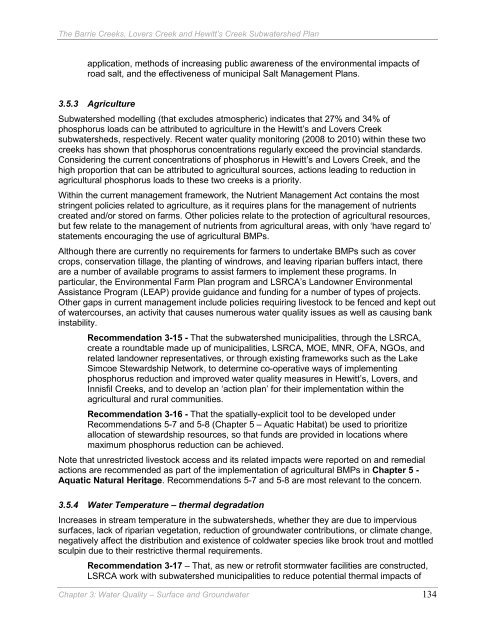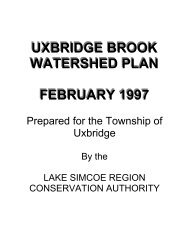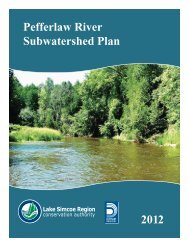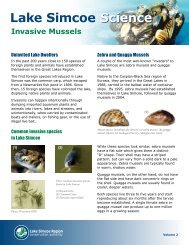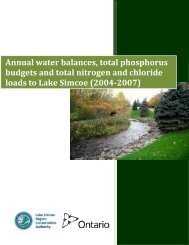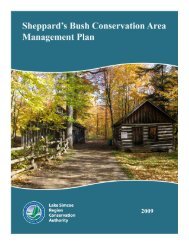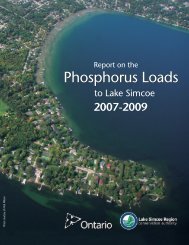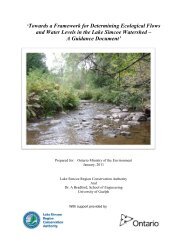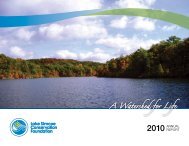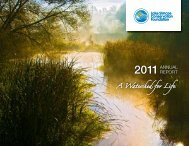Barrie Creeks, Lovers Creek, and Hewitt's Creek Subwatershed Plan
Barrie Creeks, Lovers Creek, and Hewitt's Creek Subwatershed Plan
Barrie Creeks, Lovers Creek, and Hewitt's Creek Subwatershed Plan
You also want an ePaper? Increase the reach of your titles
YUMPU automatically turns print PDFs into web optimized ePapers that Google loves.
The <strong>Barrie</strong> <strong><strong>Creek</strong>s</strong>, <strong>Lovers</strong> <strong>Creek</strong> <strong>and</strong> Hewitt’s <strong>Creek</strong> <strong>Subwatershed</strong> <strong>Plan</strong><br />
application, methods of increasing public awareness of the environmental impacts of<br />
road salt, <strong>and</strong> the effectiveness of municipal Salt Management <strong>Plan</strong>s.<br />
3.5.3 Agriculture<br />
<strong>Subwatershed</strong> modelling (that excludes atmospheric) indicates that 27% <strong>and</strong> 34% of<br />
phosphorus loads can be attributed to agriculture in the Hewitt’s <strong>and</strong> <strong>Lovers</strong> <strong>Creek</strong><br />
subwatersheds, respectively. Recent water quality monitoring (2008 to 2010) within these two<br />
creeks has shown that phosphorus concentrations regularly exceed the provincial st<strong>and</strong>ards.<br />
Considering the current concentrations of phosphorus in Hewitt’s <strong>and</strong> <strong>Lovers</strong> <strong>Creek</strong>, <strong>and</strong> the<br />
high proportion that can be attributed to agricultural sources, actions leading to reduction in<br />
agricultural phosphorus loads to these two creeks is a priority.<br />
Within the current management framework, the Nutrient Management Act contains the most<br />
stringent policies related to agriculture, as it requires plans for the management of nutrients<br />
created <strong>and</strong>/or stored on farms. Other policies relate to the protection of agricultural resources,<br />
but few relate to the management of nutrients from agricultural areas, with only ‘have regard to’<br />
statements encouraging the use of agricultural BMPs.<br />
Although there are currently no requirements for farmers to undertake BMPs such as cover<br />
crops, conservation tillage, the planting of windrows, <strong>and</strong> leaving riparian buffers intact, there<br />
are a number of available programs to assist farmers to implement these programs. In<br />
particular, the Environmental Farm <strong>Plan</strong> program <strong>and</strong> LSRCA’s L<strong>and</strong>owner Environmental<br />
Assistance Program (LEAP) provide guidance <strong>and</strong> funding for a number of types of projects.<br />
Other gaps in current management include policies requiring livestock to be fenced <strong>and</strong> kept out<br />
of watercourses, an activity that causes numerous water quality issues as well as causing bank<br />
instability.<br />
Recommendation 3-15 - That the subwatershed municipalities, through the LSRCA,<br />
create a roundtable made up of municipalities, LSRCA, MOE, MNR, OFA, NGOs, <strong>and</strong><br />
related l<strong>and</strong>owner representatives, or through existing frameworks such as the Lake<br />
Simcoe Stewardship Network, to determine co-operative ways of implementing<br />
phosphorus reduction <strong>and</strong> improved water quality measures in Hewitt’s, <strong>Lovers</strong>, <strong>and</strong><br />
Innisfil <strong><strong>Creek</strong>s</strong>, <strong>and</strong> to develop an ‘action plan’ for their implementation within the<br />
agricultural <strong>and</strong> rural communities.<br />
Recommendation 3-16 - That the spatially-explicit tool to be developed under<br />
Recommendations 5-7 <strong>and</strong> 5-8 (Chapter 5 – Aquatic Habitat) be used to prioritize<br />
allocation of stewardship resources, so that funds are provided in locations where<br />
maximum phosphorus reduction can be achieved.<br />
Note that unrestricted livestock access <strong>and</strong> its related impacts were reported on <strong>and</strong> remedial<br />
actions are recommended as part of the implementation of agricultural BMPs in Chapter 5 -<br />
Aquatic Natural Heritage. Recommendations 5-7 <strong>and</strong> 5-8 are most relevant to the concern.<br />
3.5.4 Water Temperature – thermal degradation<br />
Increases in stream temperature in the subwatersheds, whether they are due to impervious<br />
surfaces, lack of riparian vegetation, reduction of groundwater contributions, or climate change,<br />
negatively affect the distribution <strong>and</strong> existence of coldwater species like brook trout <strong>and</strong> mottled<br />
sculpin due to their restrictive thermal requirements.<br />
Recommendation 3-17 – That, as new or retrofit stormwater facilities are constructed,<br />
LSRCA work with subwatershed municipalities to reduce potential thermal impacts of<br />
Chapter 3: Water Quality – Surface <strong>and</strong> Groundwater 134


